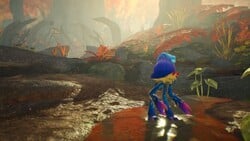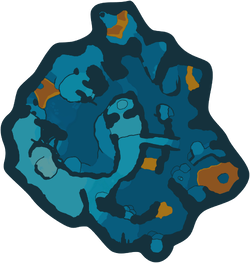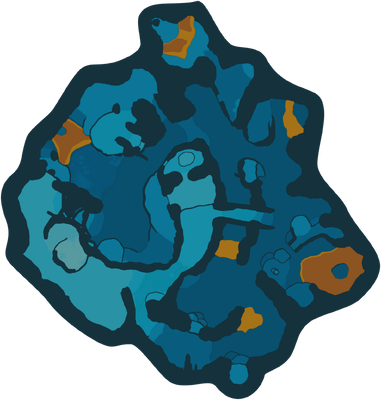Primordial Thicket: Difference between revisions
m (Added JP name to first sentence) |
|||
| (13 intermediate revisions by 8 users not shown) | |||
| Line 14: | Line 14: | ||
|music = [[Music in Pikmin 4#Primordial Thicket|''Primordial Thicket'']] | |music = [[Music in Pikmin 4#Primordial Thicket|''Primordial Thicket'']] | ||
}} | }} | ||
The '''Primordial Thicket''' is the sixth and final [[area]] in ''[[Pikmin 4]]''. It is set in a large autumnal and muddy forest. It contains 15 surface treasures, 74 cave treasures, 8 rescues (5 castaways and 3 leaflings), and 3 [[Onion]]s. There are 7 caves in total, with one being a [[Dandori Battle]] cave and three being [[Dandori Challenge]] caves. This area has {{sparklium|p4|7,750}} worth of treasure, of which {{sparklium|p4|2,580}} is above ground. | |||
The '''Primordial Thicket''' ({{j|追憶の原生林|Tsuioku no Genseirin|Primeval Forest of Recollection}}) is the sixth and final [[area]] in ''[[Pikmin 4]]''. It is set in a large autumnal and muddy forest. It contains 15 surface treasures, 74 cave treasures, 8 rescues (5 castaways and 3 leaflings), and 3 [[Onion]]s. There are 7 caves in total, with one being a [[Dandori Battle]] cave and three being [[Dandori Challenge]] caves. This area has {{sparklium|p4|7,750}} worth of treasure, of which {{sparklium|p4|2,580}} is above ground. | |||
==Plot== | ==Plot== | ||
| Line 35: | Line 36: | ||
=== Bases === | === Bases === | ||
* The Sylvan Gate: the default landing site | * The Sylvan Gate: the default landing site | ||
* The Autumnal Gully: guarded by a [[Baldy Long Legs]] | * The Autumnal Gully: guarded by a [[Baldy Long Legs]] and three [[sticky mold]]s | ||
* The Maple Bridge: guarded by | * The Maple Bridge: guarded by a large egg containing 5 [[raw material]]s and an egg containing [[Mitites]] | ||
== Caves == | == Caves == | ||
| Line 138: | Line 139: | ||
*{{icon|Cardboard box|y}} × 1 | *{{icon|Cardboard box|y}} × 1 | ||
*{{icon|Dirt wall|v=P4|y}} × 1 | *{{icon|Dirt wall|v=P4|y}} × 1 | ||
*{{icon|Iron fence|v=P4|y}} × 1 | |||
*{{icon|Mud pool|v=P4|y}} × 6 | *{{icon|Mud pool|v=P4|y}} × 6 | ||
*{{icon|Narrow tunnel|v=P4|y}} × 2 | *{{icon|Narrow tunnel|v=P4|y}} × 2 | ||
*{{icon|Poison emitter|v=P4|y}} × 3 | *{{icon|Poison emitter|v=P4|y}} × 3 | ||
*{{icon|Poison Spotcap|v=P4|y}} × 48 | |||
*{{icon|Spotcap|v=P4|y}} × 119 | |||
*{{icon|Sticky mold|v=P4|y}} × 44 | *{{icon|Sticky mold|v=P4|y}} × 44 | ||
}} | }} | ||
| Line 147: | Line 151: | ||
{{columns|2| | {{columns|2| | ||
*{{icon|Bouncy Mushroom|v=P4|y}} × 7 | *{{icon|Bouncy Mushroom|v=P4|y}} × 7 | ||
*{{icon|Clay bridge incomplete|v=P4|y|l=Clay#Clay bridge|n=Clay bridge}} × 1 | |||
*{{icon|Clay mound incomplete|v=P4|y|l=Clay#Clay mound|n=Clay mound}} × 1 | |||
*{{icon|Climbing rope|v=P4|y}} × 1 | *{{icon|Climbing rope|v=P4|y}} × 1 | ||
*{{icon|Climbing wall incomplete|v=P4|y|l=Clay#Climbing wall|n=Climbing wall}} × 1 | |||
*{{icon|Dirt-mound|y|v=P4}} × 3 (10 raw materials each) | *{{icon|Dirt-mound|y|v=P4}} × 3 (10 raw materials each) | ||
*{{icon|Geyser|v=P4|y}} × 2 | *{{icon|Geyser|v=P4|y}} × 2 | ||
| Line 185: | Line 192: | ||
** Pile of 5 × 9 | ** Pile of 5 × 9 | ||
** Pile of 10 × 10 | ** Pile of 10 × 10 | ||
** Pile of 15 × | ** Pile of 15 × 9 (Spotty Bulbears drop 1 pile each) | ||
** Pile of 20 × 3 | ** Pile of 20 × 3 | ||
** Pile of 30 × | ** Pile of 25 × 2 (Smoky Proggs drop 1 pile each) | ||
** Pile of 30 × 1 | |||
{{clear}} | {{clear}} | ||
| Line 218: | Line 226: | ||
** Pile of 15 × 4 | ** Pile of 15 × 4 | ||
** Pile of 20 × 1 | ** Pile of 20 × 1 | ||
** Pile of 25 × 6 (Baldy Long Legs, Emperor Bulblaxes, and Smoky Proggs drop 1 pile each) | |||
{{clear}} | {{clear}} | ||
| Line 268: | Line 277: | ||
}} | }} | ||
{{needs translation|Chinese|Dutch|Korean|Spanish}} | |||
'''The Sylvan Gate''' | '''The Sylvan Gate''' | ||
{{foreignname | {{foreignname | ||
|Jap = | |Jap = 樹海の入口 | ||
|JapR = | |JapR = Jyukai no Iriguchi | ||
|JapM = | |JapM = Entrance to the sea of trees | ||
|ChiTrad = | |ChiTrad = 樹海入口 | ||
|ChiTradR = | |ChiTradR = | ||
|ChiTradM = | |ChiTradM = | ||
| Line 279: | Line 289: | ||
|ChiSimpR = | |ChiSimpR = | ||
|ChiSimpM = | |ChiSimpM = | ||
|Dut = | |Dut = Woudgebergte | ||
|DutM = | |DutM = | ||
|Fra = Porte de la forêt | |Fra = Porte de la forêt | ||
| Line 287: | Line 297: | ||
|Ita = Entrata silvestre | |Ita = Entrata silvestre | ||
|ItaM = Sylvan entrance | |ItaM = Sylvan entrance | ||
|Kor = | |Kor = 수해의 입구 | ||
|KorM = | |KorM = | ||
|Spa = | |Spa = Entrada al bosque | ||
|SpaM = | |SpaM = Entrance to the forest | ||
|Por = Entrada silvestre | |Por = Entrada silvestre | ||
|PorM = Sylvan entrance | |PorM = Sylvan entrance | ||
| Line 297: | Line 307: | ||
'''The Autumnal Gully''' | '''The Autumnal Gully''' | ||
{{foreignname | {{foreignname | ||
|Jap = | |Jap = 枯葉平原 | ||
|JapR = | |JapR = Kareha Heigen | ||
|JapM = | |JapM = Plain of dead leaves | ||
|ChiTrad = | |ChiTrad = 枯葉平原 | ||
|ChiTradR = | |ChiTradR = | ||
|ChiTradM = | |ChiTradM = | ||
|ChiSimp = | |ChiSimp = 枯叶平原 | ||
|ChiSimpR = | |ChiSimpR = | ||
|ChiSimpM = | |ChiSimpM = | ||
|Dut = | |Dut = Herfstgroeve | ||
|DutM = | |DutM = | ||
|Fra = Ravin automnal | |Fra = Ravin automnal | ||
| Line 314: | Line 324: | ||
|Ita = Valle autunnale | |Ita = Valle autunnale | ||
|ItaM = Autumnal valley | |ItaM = Autumnal valley | ||
|Kor = | |Kor = 낙엽 평원 | ||
|KorM = | |KorM = | ||
|Spa = | |Spa = Llanura otoñal | ||
|SpaM = | |SpaM = Autumnal plain | ||
|Por = Vale outonal | |Por = Vale outonal | ||
|PorM = Autumnal valley | |PorM = Autumnal valley | ||
| Line 324: | Line 334: | ||
'''The Maple Bridge''' | '''The Maple Bridge''' | ||
{{foreignname | {{foreignname | ||
|Jap = | |Jap = 紅葉橋のたもと | ||
|JapR = | |JapR = Kōyō Bashi no Tamoto | ||
|JapM = | |JapM = Vicinity of the Autumnal Leaf Bridge | ||
|ChiTrad = | |JapN = {{tt|紅葉|kōyō}} could also be read as Momiji, which is Japanese Maple. Kōyō refers to the reddening of leaves in autumn | ||
|ChiTrad = 紅葉橋底下 | |||
|ChiTradR = | |ChiTradR = | ||
|ChiTradM = | |ChiTradM = | ||
|ChiSimp = | |ChiSimp = 红叶桥底下 | ||
|ChiSimpR = | |ChiSimpR = | ||
|ChiSimpM = | |ChiSimpM = | ||
|Dut = | |Dut = Brug der esdoorns | ||
|DutM = | |DutM = | ||
|Fra = Pont de l'érable | |Fra = Pont de l'érable | ||
| Line 341: | Line 352: | ||
|Ita = Ponte degli aceri | |Ita = Ponte degli aceri | ||
|ItaM = Maple bridge | |ItaM = Maple bridge | ||
|Kor = | |Kor = 단풍잎 다리 근처 | ||
|KorM = | |KorM = | ||
|Spa = | |Spa = Mesa de gigante | ||
|SpaM = | |SpaM = | ||
|Por = Ponte de bordo | |Por = Ponte de bordo | ||
|PorM = Maple bridge | |PorM = Maple bridge | ||
|notes = y | |||
}} | }} | ||
Latest revision as of 11:53, November 16, 2024
| Primordial Thicket | |
|---|---|
| Rescues | 8 |
| Treasures | 89 |
| Onions | 3 |
| Caves | 3 |
| Dandori Challenges | 3 |
| Dandori Battles | 1 |
| Suggested Pikmin | |
| Wild Pikmin | |
| Requirements | |
| Music | Primordial Thicket |
The Primordial Thicket (追憶の原生林?, lit.: "Primeval Forest of Recollection") is the sixth and final area in Pikmin 4. It is set in a large autumnal and muddy forest. It contains 15 surface treasures, 74 cave treasures, 8 rescues (5 castaways and 3 leaflings), and 3 Onions. There are 7 caves in total, with one being a Dandori Battle cave and three being Dandori Challenge caves. This area has ![]() × 7,750 worth of treasure, of which
× 7,750 worth of treasure, of which ![]() × 2,580 is above ground.
× 2,580 is above ground.
Plot[edit]
After the Rescue Corps reunites Yorke and Don Bergman, Don Bergman remembers seeing a dog-like creature drag their partner Nelle deeper into a forest. Yorke upgrades the S.S. Shepherd so that it can scan this area.
Right as the player character and Oatchi set foot in the Primordial Thicket, they see Louie and Moss holding an unconscious Nelle. They follow Louie into a cave where he tries to turn Nelle into a leafling, as he had attempted with Yorke. The process fails again and Louie challenges them to a Dandori Battle. Upon defeat, Louie runs away, abandoning Nelle as well as Moss. The morning after Nelle is rescued, she informs the crew that to cure Oatchi's tail, they will need cells from a non-leafling dog.
An entry in Louie's voyage log reveals that he found a large dog called the Ancient Sirehound, whose den is in the Cavern for a King. When the Rescue Corps duo confonts Louie at the bottom of the cave, he climbs on top the dog which proceeds to attack. Defeating the Ancient Sirehound yields Louie and the dog's collar. Yonny extracts some of the Ancient Sirehound's cells from the collar and makes a cure that reverts Oatchi to normal, allowing everyone to leave PNF-404 safely.
Layout[edit]
|
The following article or section is in need of assistance from someone who plays Pikmin 4. |
|
This section is a stub. You can help Pikipedia by expanding it. |
The following notable features can be found in this area.
- As part of the playable terrain:
- Several clumps of sticky mold
- Mud both shallow and deep
- Dirt and grass
- Several ledges and cliffs in portions of rock-like textures
Bases[edit]
- The Sylvan Gate: the default landing site
- The Autumnal Gully: guarded by a Baldy Long Legs and three sticky molds
- The Maple Bridge: guarded by a large egg containing 5 raw materials and an egg containing Mitites
Caves[edit]
| Image | Name | Sublevels | Castaways | Treasures | Onions | Suggested Pikmin | Wild Pikmin |
|---|---|---|---|---|---|---|---|

|
Cavern for a King | 20 | 1 | 48 | 0 | None | |

|
The Mud Pit | 3 | 1 | 11 | 1 | ||

|
Subterranean Swarm | 5 | 2 | 13 | 0 | None |
Dandori Challenge 1[edit]
This Dandori Challenge can be accessed by building the large clay bridge near The Maple Bridge base, and jumping up to the elevated entrance with Oatchi. Building the climbing wall near the Puffstool area can help you reach the area, but Oatchi is still needed and cannot access the area through this method.
Dandori Challenge 2[edit]
This Dandori Challenge is across a shallow mud puddle near The Autumnal Gully base. It can also be accessed through a tunnel on the other side of the map, if the map is instead traversed clockwise.
Dandori Challenge 3[edit]
This Dandori Challenge must be accessed by pushing a Cardboard Box down in the Beckoning Mannequin area, past the dirt wall near the Autumnal Gully base. To do this, White Pikmin are needed to destroy the poison geysers. Destroying them will guide the Pikmin toward the box, and they will lock on automatically. If you do not throw enough White Pikmin (10) to push down the box, you can throw Pikmin from the other side of the wall once the poison has been eliminated. From there, Oatchi is needed to jump up the slopes to the cave's entrance across the box.
Dandori Battle[edit]
The area's Dandori Battle cave, Final Battle, is located in the northeastern part of the map. It can be accessed by using Oatchi's rush to grow potted mushrooms. His jump is then needed to cross the mushrooms and access the ledge with Louie, Moss, and Nelle.
Objects[edit]
Treasures[edit]
 Bathing Pool × 1
Bathing Pool × 1 Beckoning Mannequin × 1
Beckoning Mannequin × 1 Crunchy Deluge × 1
Crunchy Deluge × 1 Delectable Bouquet × 1
Delectable Bouquet × 1 Dusk Pustules × 1
Dusk Pustules × 1 Fastening Item × 2
Fastening Item × 2 Faux Fishy × 1
Faux Fishy × 1 Gold Nugget × 10
Gold Nugget × 10 Golden Vaulting Table × 1
Golden Vaulting Table × 1 Heroic Shield × 1
Heroic Shield × 1 Heroine's Tear × 1
Heroine's Tear × 1 Mock Bottom × 1
Mock Bottom × 1 Portable Sunset × 1
Portable Sunset × 1 Scaly Custard × 1
Scaly Custard × 1 Searing Acidshock × 1
Searing Acidshock × 1 Tremendous Sniffer × 1
Tremendous Sniffer × 1
Onions[edit]
 Flarlic × 1
Flarlic × 1 Winged Onion × 1
Winged Onion × 1
Enemies[edit]
 Baldy Long Legs × 1
Baldy Long Legs × 1 Bogswallow × 4
Bogswallow × 4 Doodlebug × 2
Doodlebug × 2 Flighty Joustmite × 4
Flighty Joustmite × 4 Grubchucker × 2
Grubchucker × 2 Honeywisp × 4
Honeywisp × 4 Iridescent Glint Beetle × 1
Iridescent Glint Beetle × 1 Mitite × 40 (20 inside eggs, 10 under mold, 10 inside Doodlebug)
Mitite × 40 (20 inside eggs, 10 under mold, 10 inside Doodlebug) Moldy Dwarf Bulborb × 8
Moldy Dwarf Bulborb × 8 Moldy Slooch × 8
Moldy Slooch × 8 Muckerskate × 5
Muckerskate × 5 Puffstool × 1
Puffstool × 1 Red Spectralids × 3
Red Spectralids × 3 Shearflea × 13
Shearflea × 13 Startle Spore × 3
Startle Spore × 3
Obstacles[edit]
 Cardboard box × 1
Cardboard box × 1 Dirt wall × 1
Dirt wall × 1 Iron fence × 1
Iron fence × 1 Mud pool × 6
Mud pool × 6 Narrow tunnel × 2
Narrow tunnel × 2 Poison emitter × 3
Poison emitter × 3 Poison Spotcap × 48
Poison Spotcap × 48 Spotcap × 119
Spotcap × 119 Sticky mold × 44
Sticky mold × 44
Tools[edit]
 Bouncy Mushroom × 7
Bouncy Mushroom × 7 Clay bridge × 1
Clay bridge × 1 Clay mound × 1
Clay mound × 1 Climbing rope × 1
Climbing rope × 1 Climbing wall × 1
Climbing wall × 1 Dirt-mound × 3 (10 raw materials each)
Dirt-mound × 3 (10 raw materials each) Geyser × 2
Geyser × 2 Potted mushroom × 2
Potted mushroom × 2
Others[edit]
 Burgeoning Spiderwort × 4
Burgeoning Spiderwort × 4 Egg × 8 (6 × small, 2 × large)
Egg × 8 (6 × small, 2 × large) Pellet Posy × 12 (9 × 1 pellet, 3 × 5 pellet)
Pellet Posy × 12 (9 × 1 pellet, 3 × 5 pellet) Pile of raw material × 6 (1 pile of 15, 4 piles of 24, 1 pile of 30)
Pile of raw material × 6 (1 pile of 15, 4 piles of 24, 1 pile of 30)
Night expeditions[edit]
The Sylvan Gate[edit]
| The Sylvan Gate | |
|---|---|
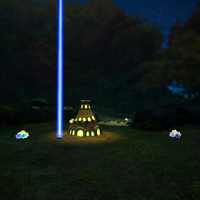
| |
| Danger level | |
| Lumiknolls | 1 |
| Enemies | 21 |
| Starting Glow Pikmin | 10 |
There is one Lumiknoll located directly at the base. This location has a danger level of 4 and starts the player off with 10 Glow Pikmin.
Enemies[edit]
 Bulborb Larva × infinite (2 nests)
Bulborb Larva × infinite (2 nests) Dwarf Bulbear × 9
Dwarf Bulbear × 9 Moldy Dwarf Bulborb × 3
Moldy Dwarf Bulborb × 3 Smoky Progg × 2
Smoky Progg × 2 Spotty Bulbear × 4
Spotty Bulbear × 4
Objects[edit]
 Glow pellet × 420
Glow pellet × 420
- Pile of 5 × 9
- Pile of 10 × 10
- Pile of 15 × 9 (Spotty Bulbears drop 1 pile each)
- Pile of 20 × 3
- Pile of 25 × 2 (Smoky Proggs drop 1 pile each)
- Pile of 30 × 1
Autumnal Gully[edit]
| Autumnal Gully | |
|---|---|
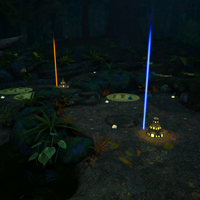
| |
| Danger level | |
| Lumiknolls | 2 |
| Enemies | 24 |
| Starting Glow Pikmin | 10 |
There are two Lumiknolls, the blue one located directly at the base and the orange one located in the southwest, on the path leading between this base and The Sylvan Gate base. This location has a danger level of 5 and starts the player off with 10 Glow Pikmin.
Enemies[edit]
 Baldy Long Legs × 1
Baldy Long Legs × 1 Emperor Bulblax × 3
Emperor Bulblax × 3 Moldy Dwarf Bulborb × 13
Moldy Dwarf Bulborb × 13 Moldy Slooch × 5
Moldy Slooch × 5 Smoky Progg × 2
Smoky Progg × 2
Objects[edit]
 Glow pellet × 375
Glow pellet × 375
- Pile of 5 × 1
- Pile of 10 × 14
- Pile of 15 × 4
- Pile of 20 × 1
- Pile of 25 × 6 (Baldy Long Legs, Emperor Bulblaxes, and Smoky Proggs drop 1 pile each)
Guide[edit]
|
This section is a stub. You can help Pikipedia by expanding it. |
Gallery[edit]
|
This article or section is in need of more images. |
A Burgeoning Spiderwort near the Golden Vaulting Table.
The entrance to the Cavern for a King.
Trivia[edit]
- This is the only area in the game where Winged Pikmin and White Pikmin are recommended for use overground, and the only area in the game where none of the three primary Pikmin types are recommended for use.
- The three recommended Pikmin are also the only ones to have a lower attack power.
- This is the only area in the game to have more than two Burgeoning Spiderworts.
Names in other languages[edit]
Primordial Thicket
| Language | Name | Meaning |
|---|---|---|
| 追憶の原生林? Tsuioku no Genseirin |
Primeval Forest of Recollection | |
(traditional) |
追憶的原生林 Zhuīyì de Yuánshēnglín |
Old-Growth Forest of Recollection |
(simplified) |
追忆的原生林 Zhuīyì de Yuánshēnglín |
Old-Growth Forest of Recollection |
| Vergeten woud | Forgotten forest | |
| Forêt primaire | Primary forest | |
| Urwalddickicht | Primeval Thicket | |
| Bosco primordiale | Primordial forest | |
| 추억의 원시림 Chueog-ui Wonsirim |
Primeval Forest of Recollection | |
| Floresta inexplorada | Unexplored forest | |
| Territorio salvaje | Wild territory |
|
The following article or section needs help from someone who can translate Chinese/Dutch/Korean/Spanish text. |
The Sylvan Gate
| Language | Name | Meaning |
|---|---|---|
| 樹海の入口? Jyukai no Iriguchi |
Entrance to the sea of trees | |
(traditional) |
樹海入口 | |
| Woudgebergte | ||
| Porte de la forêt | Forest gate | |
| Waldtor | Forest gate | |
| Entrata silvestre | Sylvan entrance | |
| 수해의 입구 | ||
| Entrada silvestre | Sylvan entrance | |
| Entrada al bosque | Entrance to the forest |
The Autumnal Gully
| Language | Name | Meaning |
|---|---|---|
| 枯葉平原? Kareha Heigen |
Plain of dead leaves | |
(traditional) |
枯葉平原 | |
(simplified) |
枯叶平原 | |
| Herfstgroeve | ||
| Ravin automnal | Autumnal ravine | |
| Herbstebene | Autumnal level | |
| Valle autunnale | Autumnal valley | |
| 낙엽 평원 | ||
| Vale outonal | Autumnal valley | |
| Llanura otoñal | Autumnal plain |
The Maple Bridge
| Language | Name | Meaning | Notes |
|---|---|---|---|
| 紅葉橋のたもと? Kōyō Bashi no Tamoto |
Vicinity of the Autumnal Leaf Bridge | 紅葉 could also be read as Momiji, which is Japanese Maple. Kōyō refers to the reddening of leaves in autumn | |
(traditional) |
紅葉橋底下 | ||
(simplified) |
红叶桥底下 | ||
| Brug der esdoorns | |||
| Pont de l'érable | Maple bridge | ||
| Ahornbrücke | Maple bridge | ||
| Ponte degli aceri | Maple bridge | ||
| 단풍잎 다리 근처 | |||
| Ponte de bordo | Maple bridge | ||
| Mesa de gigante |
See also[edit]
| Pikmin 4 areas |
|---|
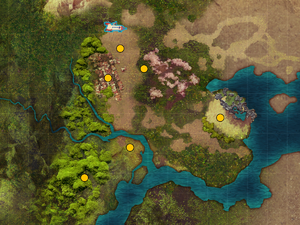 Click an area on the image Rescue Command Post • Sun-Speckled Terrace • Blossoming Arcadia • Serene Shores • Hero's Hideaway • Giant's Hearth • Primordial Thicket |
